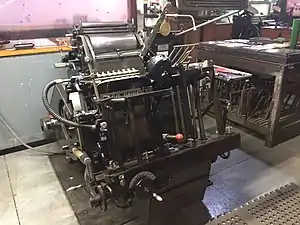Original Heidelberg Platen Press
The Original Heidelberg Platen Press was a letterpress printing press manufactured by the Heidelberger Druckmaschinen company in Germany. It was often referred to as the "Windmill", after the shape and movement of its paper feed system. When introduced, it was also called the "Super Heidelberg" or the "Super Speed".[1]

History
The Original Heidelberg Platen Press was introduced in 1914[2] and manufactured between 1923 and 1985.[3][4]
The company later also produced the Original Heidelberg Cylinder Press and today produces offset presses and printing related products. The name Original Heidelberg Platen Press the most descriptive.
There have been many models of the press. The most visible change is the colour of the control knobs: earlier models had black knobs and newer models had red knobs. But there are many less obvious changes over the years, as the design has continuously evolved over its lifetime.
Design and operation
The printing press is most famous for its windmill-like automatic paper feed mechanism. There are two blades that rotate from the paper feed, where it picks up a sheet of paper; to the platen, where the printing impression is made; to the paper receiver, where the paper is released; followed by the blade pointing straight up ready to start the next cycle. There are two blades mounted on opposite sides of the rotor (when one blade is picking up the next sheet, the other blade is releasing the previously printed sheet).[5]
A clam shell-like mechanism performs the actual printing. In letterpress an impression is made on the paper by having a plate press the paper against a form. The form has the desired image in reverse: with raised parts where the ink is applied, and lowered parts where the ink is not applied. When a rotor has moved a page to the platen, the plate is pressed closed against the form to make the impression (where ink is transferred from the form to the paper). The plate then opens up to release the printed page and allow the rollers to apply more ink to the form. This cycle repeats for the next page.
The Original Heidelberg Platen Press also automatically inks the rollers. Ink can be added to a reservoir, which is then spread evenly via several rollers before reaching the rollers which make contact with the form.
The press is driven by an electric motor that runs a flywheel. The motor is a three-phase electrical motor, but some operators have replaced it with a single-phase electrical motor, since single-phase electrical supplies are more commonly found.
The press also contains an air pump. Air suction is used to pick up the next sheet of paper from the feed pile, so the blade can grab it as it comes around.
Models
Two models of the press were manufactured: the Original Heidelberg 10" x 15" and the larger Original Heidelberg 13" x 18" that can print on larger sheets of paper.[6]
Use today
Although the Original Heidelberg Platen Press is no longer being manufactured, it is still in wide use for commercial and enthusiast letterpress printing. Most commercial printing these days is done using offset printing and digital printing, but letterpress printing is still popular for artisan and special occasion printing jobs (e.g. wedding invitations and business cards).
References
- "Heidelberg Automatic Platen". Letterpress Printing. December 2008. Retrieved 21 November 2018.
- "Heidelberger Tiegel: Upwards and Onwards". Heidelberger Druckmaschinen AG. Retrieved 21 November 2018.
- Williams, Fred (1981). "Original Heidelberg: The Prince of Presses". Type & Press. Retrieved 21 November 2018.
- "Lookup by serial number". Drupama, Printing Machinery from Germany to the World. Retrieved 21 November 2018.
- "Manual for the Operation of Heidelberg Platens" (PDF). Schnellpressenfabrik AG Heidelberg. Retrieved 21 November 2018.
- "Heidelberg Platens". British Letterpress. Retrieved 21 November 2018.